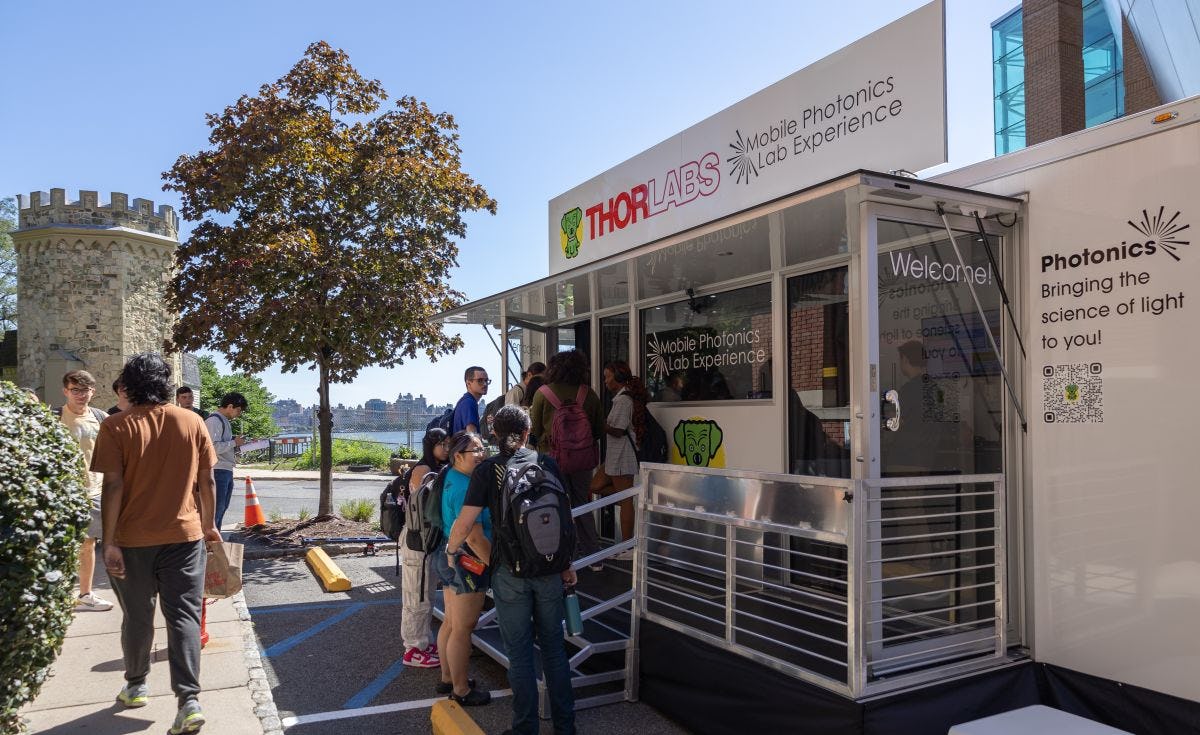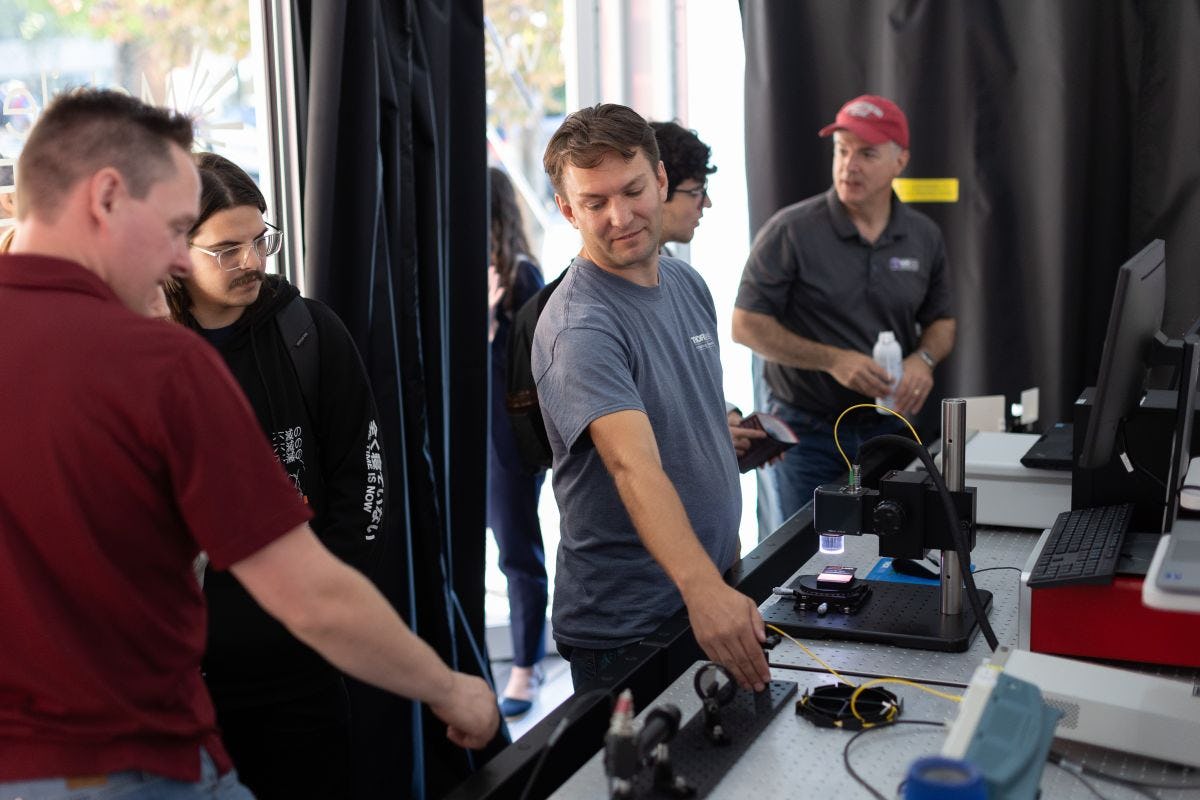In his new role as director of photonics education at Thorlabs, Bill Warger ’03 is giving high school and college students a hands-on introduction to the fascinating, growing field of photonics. In fact, he even helped create a mobile lab to take that message on the road.
Early on, Bill Warger ’03 was fairly certain he would pursue a career in engineering. He had an affinity for science and math, and several members of his family were successful engineers. He also wanted to play baseball, so when he was offered a spot to play for the Ducks, his choice to study at Stevens was clear.
Electrical or computer engineering seemed likely tracks for Warger, but fate intervened and sent him on a different path. “I took AP Physics in high school and planned to test out of Physics 101 in college,” he recalls. “On exam day, my calculator stopped working and I ended up having to take the intro physics course at Stevens. Funny thing is, the next day my calculator worked just fine!”
What at first seemed like a setback happened to be a significant turn of events for Warger. “My physics professor gave us an overview of the program,” he says. “When Professor [Ed] Whittaker described the university’s work in photonics, something clicked.”
Warger never looked back.
Even though he grew up around engineers, there was still a learning curve to understand what a career in photonics would look like. “My family’s experiences only went so far,” he points out. “I got a lot of value from the Stevens co-op program.”
Warger’s co-op assignments as an engineering assistant at General Motors, Airtron, Princeton Plasma Physics Lab and C Technologies helped him understand what it was like to work in different environments, including research. “I learned what I did and more importantly what I didn’t want to do,” he says.
One lesson he took to heart was the importance of graduate school. He earned an M.S. and a Ph.D. in electrical engineering at Northeastern University, which added another unexpected development to his journey. “Before I went to Stevens, I thought it might be nice to move south to a warmer climate,” he says. “Instead, I ended up living in New England.”
While at Northeastern, Warger worked as a teaching and research assistant in the university’s Bernard M. Gordon Center for Subsurface Sensing and Imaging Systems. He even spent a year as interim manager of the Center’s Keck 3D Fusion Microscope Facility. He followed his time at Northeastern with three years as a research fellow at the Massachusetts General Hospital/Harvard Medical School Wellman Center for Photomedicine.
In 2012, Warger returned to New Jersey with the idea of creating a biomedical optics program in the state. “It was not something readily available in New Jersey at the time,” he says.
Before pursuing that idea fully, however, he joined Thorlabs as a photonics lab specialist to supervise tech support lab rotations and also became responsible for new product development review and product standardization. “I was having some doubts about staying in academia,” he explains. “I wanted to see what a corporate career might be like. Thorlabs was a great fit because my role had an educational component. As supervisor of the company’s tech support labs, I was teaching engineers different approaches and helping them create results that could be shared.”
“About ten years into my time at Thorlabs I no longer had the bandwidth to divide my attention between engineering and education,” he continues. “It was time to fully commit to one direction and I chose education.”
Thorlabs supported Warger’s vision of outreach, education and dissemination, and created a new role for him in 2023: director of photonics education.
“We started by bringing photonics education to high schools and colleges around the country to introduce the field and to let students know that photonics is a great career option,” he says. “We created a mobile lab – a truck and trailer with two optical tables.”
What Warger describes as a “truck and a trailer with two optical tables” is, in reality, a platform for some very exciting and unique hands-on activities. Warger begins by demonstrating how a live microscope can be used to see subsurface structures within students’ fingers. He then explains to them how this technology is regularly used by ophthalmologists for imaging their patients’ retinas.
Visitors to the lab move on to spectroscopy, measuring the absorption of water and carbon dioxide in the air to see how different wavelengths interact with various materials. They then learn how NASA’s James Webb Space Telescope uses spectroscopy with the same wavelength range to identify gases on other planets.
And if those demonstrations aren’t fascinating enough, there is a third that uses optical communications to send sound from a laptop to a speaker via a laser beam. Warger demonstrates how the beam, and therefore the sound, can be easily blocked by, say, someone’s hand, and then shows an enlarged image of optical fiber smaller than the size of a human hair that can transport the beam to our homes for broadband internet. He finishes showing how optical fiber works by bending light into a bucket with a stream of water.
Warger is grateful to Stevens for his own introduction to photonics, and for the academic and career preparation he experienced at Castle Point. In September 2023, his career path came full circle when the Thorlabs Mobile Lab stopped at Stevens. “Professor Whittaker was one of the first people we contacted, and his excitement led to us making Stevens our second stop on the inaugural tour,” Warger says. He was joined by fellow alum Chris Pinyan ’89, a manufacturing engineering manager at Thorlabs. Together, they sparked interest in the photonics industry and in Stevens’ optical engineering concentration.
“We enjoyed meeting students, and several stayed after the demonstrations to chat,” Warger says. “It was incredibly rewarding having the same conversation with the students that Professor Whittaker had with me when I was finding my way,” Warger adds. “Chris and I loved having the chance to share our experiences. We just hope we made working in photonics seem relatable and showed that great careers can be had in photonics.”
“There are so many opportunities to try new things at Stevens,” Warger adds. “We encourage students to explore what is out there through internships, co-ops, clubs and more, and to learn from as many people as possible. When you investigate and try new things, you have a better chance of understanding and finding what you love to do.”




